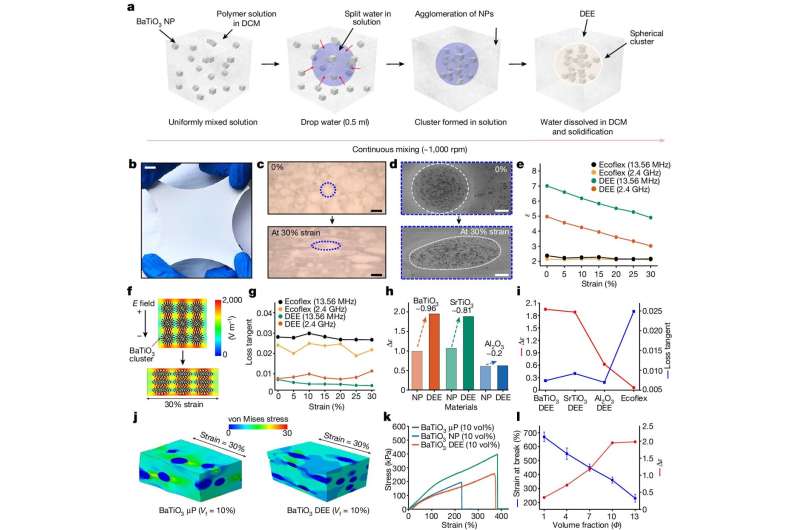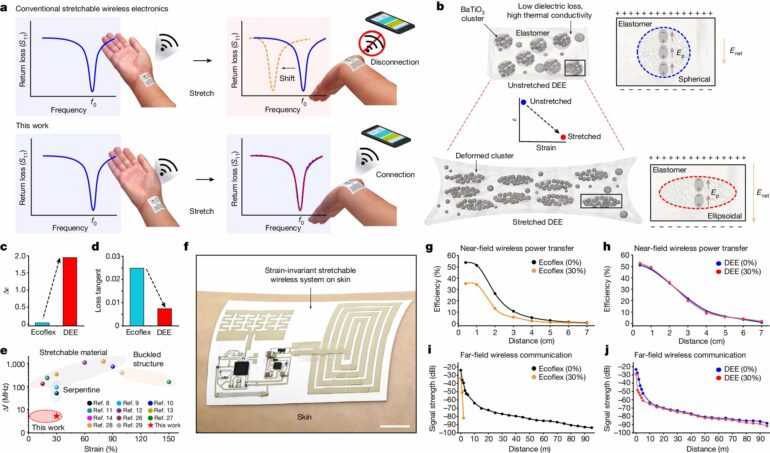A new material that moves like skin while preserving signal strength in electronics could enable the development of next-generation wearable devices with continuous, consistent wireless and battery-free functionality.
According to a study published today in Nature, an international team of researchers from Rice University and Hanyang University developed the material by embedding clusters of highly dielectric ceramic nanoparticles into an elastic polymer. The material was reverse-engineered to not only mimic skin elasticity and motion types, but also to adjust its dielectric properties to counter the disruptive effects of motion on interfacing electronics, minimize energy loss and dissipate heat.
“Our team was able to combine simulations and experiments to understand how to design a material that can seamlessly deform like skin and change the way electrical charges distribute inside it when it is stretched so as to stabilize radio-frequency communication,” said Raudel Avila , assistant professor of mechanical engineering at Rice and a lead author on the study.
“In a way, we are carefully engineering an electrical response to a mechanical event.”
Avila, who was responsible for conducting simulations to help identify the right choice of materials and design, explained that electronic devices use radio frequency (RF) elements like antennas to send and receive electromagnetic waves.
“If you have ever been in a place with poor cellular reception or a very spotty Wi-Fi signal, you probably understand the frustration of weak signals,” Avila said. “When we’re trying to communicate information, we work at specific frequencies: Two antennas communicating with each other do so at a given frequency.
“So we need to ensure that that frequency does not change so that communication remains stable. The challenge of achieving this in systems designed to be mobile and flexible is that any change or transformation in the shape of those RF components causes a frequency shift, which means you’ll experience signal disruption.”
The nanoparticles embedded in the substrate served to counteract these disruptions, with a key design element being the intentional pattern of their distribution. Both the distance between the particles and the shape of their clusters played a critical role in stabilizing the electrical properties and resonant frequency of the RF components.
“The clustering strategy is very important, and it would take a lot longer to figure out how to go about it through experimental observations alone,” Avila said.

Fabrication and characterization of DEE. © Nature (2024). DOI: 10.1038/s41586-024-07383-3
Sun Hong Kim, a former research associate from Hanyang and now a postdoctoral researcher at Northwestern University, pointed out that the research team took a creative approach to solving the problem of RF signal stability in stretchable electronics.
“Unlike previous studies that focused on electrode materials or design, we focused on the design of a high-dielectric nanocomposite for the substrate where the wireless device is located,” Kim said, highlighting the importance of collaboration across three different fields of expertise for developing. “Such a multidimensional solution to a complex problem.”
“We believe that our technology can be applied to various fields such as wearable medical devices, soft robotics and thin and light high-performance antennas,” said Abdul Basir, a former research associate from Hanyang and now a postdoctoral researcher at Tampere University in Finland.
Wearable technologies are having a profound impact on health care, enabling new forms of individual monitoring, diagnosis and care. Smart wear market predictions reflect the transformative potential of these technologies with health and fitness owning the largest share in terms of end use.
“Wireless skin-integrated stretchable electronics play a key role in health emergencies, e-health care and assistive technologies,” Basir added.
To test whether the material could support the development of effective wearable technologies, the researchers built several stretchable wireless devices, including an antenna, a coil and a transmission line, and evaluated their performance both on the substrate they developed and on a standard elastomer without the added ceramic nanoparticles.
“When we put the electronics on the substrate and then we stretch or bend it, we see that the resonant frequency of our system remains stable,” Avila said. “We showed that our system supports stable wireless communication at a distance of up to 30 meters (~98 feet) even under strain. With a standard substrate, the system completely loses connectivity.”
The wireless working distance of the far-field communication system exceeds that of any other similar skin-interfaced system. Moreover, the new material could be used to enhance wireless connectivity performance in a variety of wearable platforms designed to fit various body parts in a wide range of sizes.
For instance, the researchers developed wearable bionic bands to be worn on the head, knee, arm or wrist to monitor health data across the body, including electroencephalogram (EEG) and electromyogram (EMG) activity, knee motion and body temperature. The headband, which was shown could stretch up to 30% when worn on the head of a toddler and up to 50% on the head of an adult, successfully transmitted real-time EEG measurements at a wireless distance of 30 meters.
“Skin-interfaced stretchable RF devices that can seamlessly conform to skin morphology and monitor key physiological signals require critical design of the individual material layouts and the electronic components to yield mechanical and electrical properties and performance that do not disrupt a user’s experience,” Avila said.
“As wearables continue to evolve and influence the way society interacts with technology, particularly in the context of medical technology, the design and development of highly efficient stretchable electronics become critical for stable wireless connectivity.”
More information:
Sun Hong Kim et al, Strain-invariant stretchable radio-frequency electronics, Nature (2024). DOI: 10.1038/s41586-024-07383-3
Citation:
Wearable devices get signal boost from new material (2024, May 22)



